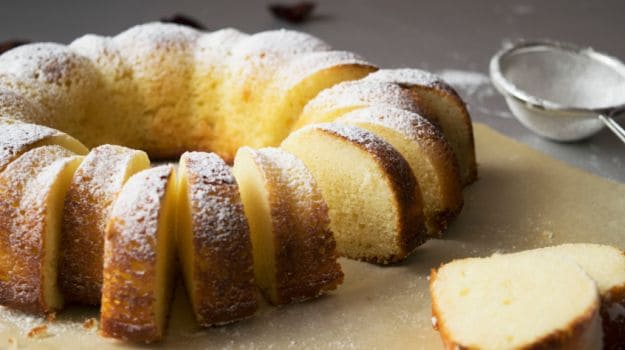The origins of pound cake lie in Northern Europe and date back to the early 18th century. Initially, the pound cake weighed four pounds; that rules out the possibility of it being named after its weight. The ingredients in the cake, however, were measured up to one pound. This is how it was traditionally made - a pound each of these four ingredients - butter, flour, sugar and eggs. The name pound cake has stuck around ever since.
Due to the traditional measurements of ingredients used in this cake, the size is such that it becomes possible to serve multiple families at a go. The modern day families, however, prefer a lighter and smaller cake and therefore the original recipe has been modified overtime as per the requirements. Today, people use smaller quantities of each ingredient, but maintain the 1:1:1:1 ratio.

Image credit: IStock
A lot of different variations of the pound cake exist now across various countries and regions, each one having their own distinct style. Originally, no leaveners were used in the cake except for the air whipped into the batter. It was only in the 1900s that artificial leaveners like baking soda and baking powder were added to reduce the density of the cake. Other variations include the addition of flavouring agents like vanilla extract/almond extract or dried fruits such as cranberries or currants. At times, some or all of the butter was substituted by a cooking oil/vegetable oil to get a moist cake. One of the most popular variations is the sour cream pound cake of United States. The butter is substituted by sour cream to moisten the cake and also get a tinge of a tangy flavour. Despite these variations which alter the characteristics and the flavour of the cake drastically, the name 'pound cake' is often used.
Pound cake is quite well known in France and is called 'quarte-quarts', or 'four quarters', a quarter referring to a pound. The Carribean part of the world that speaks French add Rum to the cake for Christmas eve along with mashed bananas. The Venezuelan and Colombian version of the Pound cake is called ponque which is a Spanish phonetic approximation of the term. It is essentially a wine drenched cake with cream/sugar coating. The Mexican version is called panque and it follows the traditional recip - a pound each of butter, flour, sugar and eggs
Disclaimer:The opinions expressed within this article are the personal opinions of the author. NDTV is not responsible for the accuracy, completeness, suitability, or validity of any information on this article. All information is provided on an as-is basis. The information, facts or opinions appearing in the article do not reflect the views of NDTV and NDTV does not assume any responsibility or liability for the same.






